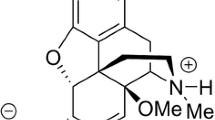Abstract
Opioids have been used for long time to management of pain, the coadministration of two opioids may induce synergism. The present study was conducted to determine the antinociceptive interaction between the dual mechanism of action of tramadol compared to the main of fentanyl antinociception in the orofacial formalin which represents a model of persistent cutaneous nociception in the region innervated by the trigeminal nerve. The i.p. administration of tramadol and fentanyl induced a dose-dependent antinociception with an ED50 of 2.97 ± 0.32 mg/kg for phase I and 1.79 ± 0.30 mg/kg for phase II and 0.062 ± 0.0040 mg/kg in phase I and 0.041 ± 0.0039 mg/kg in phase II, respectively. The coadministration of fentanyl with tramadol induced synergism in both phases of the test with an interaction index of 0.343 and 0.163 for phase I and phase II, respectively. This finding could be explained by the more complex pharmacology of tramadol compared to fentanyl.


Similar content being viewed by others
REFERENCES
Waldhoer, M., S.E. Bartlett, and J.L. Whistler. 2004. Opioid receptors. Annual Review of Biochemistry 73: 953–990.
Trescot, A.M., S. Datta, M. Lee, and H. Hansen. 2008. Opioid pharmacology. Pain Physician 11: S133–S153.
Raffa, R.B., and D.J. Stone. 2008. Unexceptional seizure potential of tramadol or its enantiomers or metabolites in mice. The Journal of Pharmacology and Experimental Therapeutics 303: 557–562.
Kelly, S., K.S. Lewis, and N.H. Han. 1997. Tramadol: a new centrally acting analgesic. American Journal of Health-System Pharmacy 54: 643–652.
Curatolo, M., and G. Sveticic. 2002. Drug combination in pain treatment: a review of the published evidence and a method for finding the optimal combination. Best Practice & Research Clinical Anaesthesiology 216: 507–512.
Smith, H.S. 2008. Combination opioids analgesics. Pain Physician 11: 202–214.
Stein, C., J.D. Clark, U. Oh, M.R. Vasko, G.L. Wilcox, A.C. Overland, T.W. Vanderah, and R.H. Spencer. 2009. Peripheral mechanisms of pain and analgesia. Brain Research Reviews 60: 90–113.
Luccarini, P., A. Childeric, A.M. Gayder, D. Voisin, and R. Dallel. 2006. The orofacial formalin test in the mouse: a behavioral model for studying physiology and modulation of trigeminal nociception. The Journal of Pain 7: 908–914.
Miranda, H.F., F. Sierralta, and J.C. Prieto. 2009. Synergism between NSAIDs in the orofacial formalin test in mice. Pharmacology, Biochemistry, and Behavior 92: 314–318.
Tallarida, R.J. 2000. Drug synergism and dose-effect data analysis. Boca Ratón: Chapman & Hall/CRC Press. p. 26-131.
Dubuisson, D., and S.G. Dennis. 1977. The formalin test: a quantitative study of the analgesic effects of morphine, meperidine, and brain stem stimulation in rats and cats. Pain 4: 161–174.
Tjølsen, A., O.-G. Berge, S. Hunskaar, J.H. Rosland, and K. Hole. 1992. The formalin test: an evaluation of the method. Pain 51: 5–17.
Sessle, B.J. 2005. Peripheral and central mechanisms of orofacial pain and their clinical correlates. Minerva Anesthesiology 71: 117–136.
Bolan, E.A., R.J. Tallarida, and G.W. Pasternak. 2002. Synergy between mu opioid ligands, evidence for functional interactions among mu opioid receptor subtypes. The Journal of Pharmacology and Experimental Therapeutics 303: 557–562.
Pan, Y.X., J. Xu, H.S. Moskowitz, M. Xu, and G.W. Pasternak. 2005. Identification of four novel exon 5 splice variants of the mouse μ- opioid receptor gene: Functional consequences of C-terminal splicing. Molecular Pharmacology 68: 866–875.
Munro, G., C.A. Baek, H.K. Erichsen, A.N. Nielsen, E.Ø. Nielsen, J. Scheel-Kruger, P. Weikop, and D. Peters. 2008. The novel compound (+/-)-1-[10-((E)-3-Phenyl-allyl)-3,10-diaza-bicyclo[4.3.1]dec-3- yl]-propan-1- one (NS7051) attenuates nociceptive transmission in animal models of experimental pain; a pharmacological comparison with the combined mu-opioid receptor agonist and monoamine reuptake inhibitor tramadol. Neuropharmacology 54: 331–343.
Ozdogan, U.K., and M.S. Lahdesmaki. 2006. The analgesic efficacy of partial opioid agonists is increased in mice with targeted inactivation of the α2A-adrenoceptor gene. European Journal of Pharmacology 529: 105–113.
Gercek, A., Z. Eti, F.Y. Gogus, and A. Sav. 2004. The analgesic and antiinflammatory effects of subcutaneous bupivacaine, morphine and tramadol in rats. Agriculture 16: 53–58.
Miranda, H.F., M.M. Puig, M.A. Romero, and J.C. Prieto. 2009. Effects of tramadol and dexketoprofen on analgesia and gastrointestinal transit in mice. Fundamental and Clinical Pharmacology 23: 81–88.
Romero, A., H.F. Miranda, and M.M. Puig. 2010. Antinociceptive effects of morphine, fentanyl, tramadol and their combination in morphine-tolerant mice. Pharmacology, Biochemistry, and Behavior 97: 363–369.
Romero, A., H.F. Miranda, and M.M. Puig. 2010. Analysis of the opioide–opioid combinations according to the nociceptive stimulus in mice. Pharmacological Research 61: 511–518.
Sirohi, S., S.V. Dighe, E.A. Walker, and B.C. Yoburn. 2008. The analgesic efficacy of fentanyl: Relationship to tolerance and μ-opioid receptor regulation. Pharmacology, Biochemistry, and Behavior 91: 115–120.
Barrera, N.P., B. Morales, S. Torres, and M. Villalon. 2005. Principles: Mechanisms and modelling of synergism in cellular responses. Trends in Pharmacological Sciences 26: 526–532.
Kenakin, T. 2007. Collateral efficacy in drug discovery: Taking advantage of the good (allosteric) nature of 7TM receptors. Trends in Pharmacological Sciences 28: 407–415.
ACKNOWLEDGMENTS
This work was partially supported by project DI-02-11/CB from Universidad Andrés Bello. The expert technical assistance of Jose Lopez and Alejandro Correa is gratefully recognized.
Author information
Authors and Affiliations
Corresponding author
Rights and permissions
About this article
Cite this article
Miranda, H.F., Noriega, V., Zepeda, R.J. et al. Synergism Between Fentanyl and Tramadol in Tonic Inflammatory Pain: the Orofacial Formalin Test. Inflammation 35, 1132–1137 (2012). https://doi.org/10.1007/s10753-011-9420-7
Published:
Issue Date:
DOI: https://doi.org/10.1007/s10753-011-9420-7



